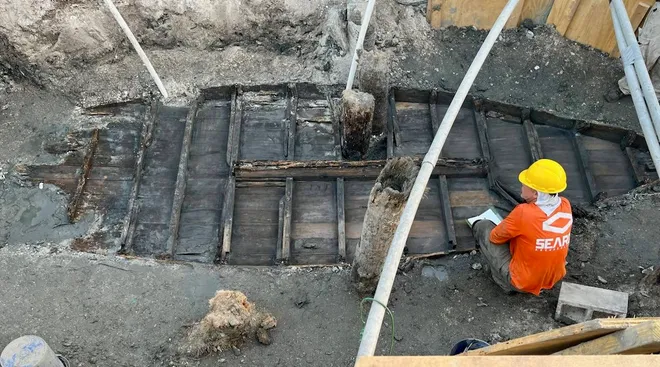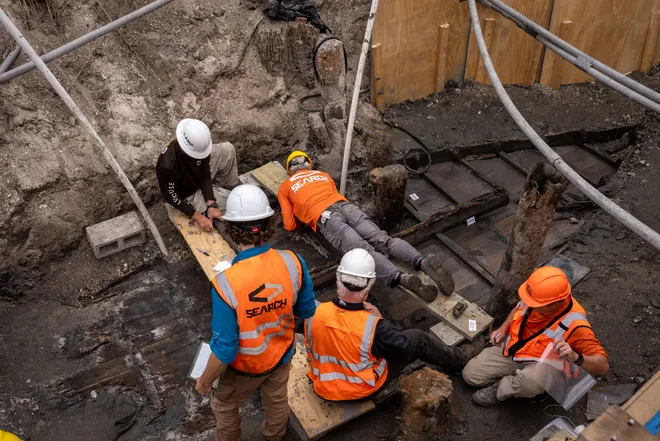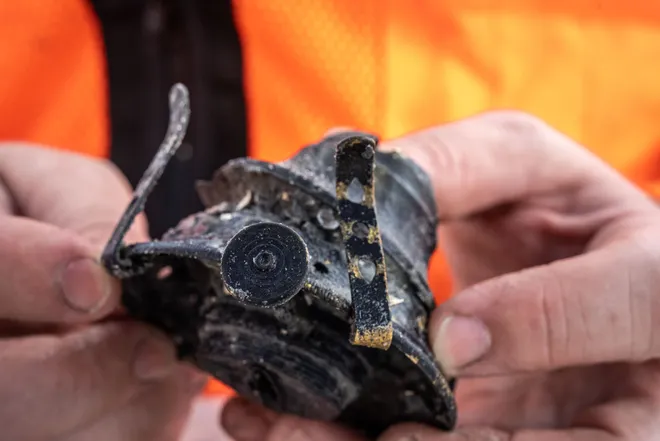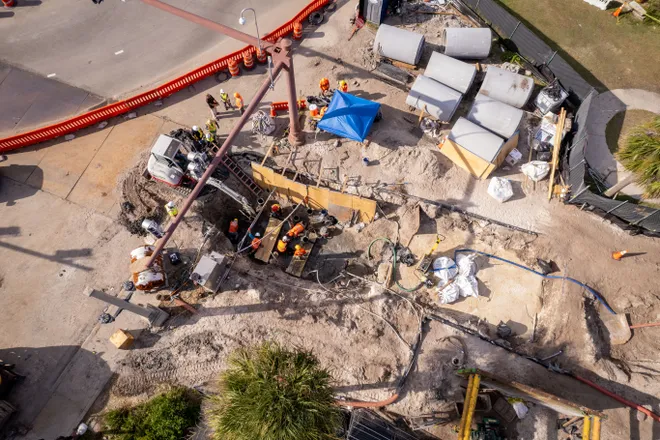Under busy Florida street, a 19th-century boat discovered where once was water
The humble, much-repaired wooden boat, about 28 feet long, with a flat bottom and single mast, had no doubt reached the end of its useful life when it was left in the mud at the edge of St. Augustine, Florida sometime in the second half of the 19th century.
Whoever left it there probably took its mast, its rigging, anything that could have been useful, but might have left behind some coins — including one dating to 1869 — as well as part of an oil-fired lamp, a cut coconut shell that might have been used as a cup and two leather shoes. Enough of the shoes remained that archaeologists could determine that there was one for someone's right foot and another for someone's left foot.
Eventually mud and water covered the boat, which helped preserve it, and it was further buried as fill was brought in to extend St. Augustine's old city to the east. At some point, a piling on a now-gone wharf was driven right through the vessel, probably as it lay unseen under the mud.

The boat was discovered recently less than a block from St. Augustine's current waterfront, just south of the Bridge of Lions, as crews worked on a drainage problem designed to ease chronic flooding in the area — which was, of course, water not too long ago.
That brought in archaeologists from SEARCH Inc. (Southeastern Archaeological Research), a cultural resource management research firm with an office in Jacksonville. The Florida Department of Transportation had sub-contracted with the company for the project because of the rich historic nature of St. Augustine, in the event of such a find.
They painstakingly excavated the boat, board by board. They finished late Wednesday, just before the heavy rainfall that moved in and would have certainly complicated the project, said James Delgado, a prominent maritime archaeologist who is now with SEARCH.
From Midway to St. Augustine

Delgado had recently been at the National Oceanic and Atmospheric Administration command post in Silver Spring, Md., watching images of the aircraft carriers lost in the Battle of Midway in 1942, captured by robotic vehicles 18,000 feet below the Pacific Ocean.
Then he got a call about the find in St. Augustine and quickly flew down.
It was quite the contrast, he said: "Thousands of deaths and a battle that changed the world’s history, and from there I find myself 8 feet down in a trench working with my colleagues on this site."
It's all about the people connected to those finds, though, he said — whether it's a young sailor on a doomed carrier in the Pacific or the owners of that humble boat in St. Augustine.
The boat most likely dates to the second half of the 19th century and was built locally, probably by the people who owned and sailed it, Delgado said. They weren't professional boat builders, but they knew how to craft a vessel that could be used for fishing, oystering or carrying goods from place to place along what was then a bustling working waterfront.
Texas A&M student deathPolice investigating after Texas A&M student dies from third-floor balcony fall

"It had been hard-worked and sailed," he said.
For much of the transportation and commerce in the area, the waters were the main thoroughfares. And mall craft such as that one were “the delivery trucks of the 19th century," he said.
When it was unearthed, the vessel was missing several feet from its hull, leaving about 19 feet of its length in place. To remove it, the boat was taken apart board by board, and each board — which by now has the consistency of thick, water-soaked cardboard — was cataloged, mapped and photographed.

Everything was taken to a wet-storage vat at the St. Augustine Lighthouse & Maritime Museum to further protect it from damaging dry air.
Archaeologists at the Lighthouse Archaeological Maritime Program worked with SEARCH on the project, as did city archaeologist Andrea White.
Maternal health careMaternity units closing in Alabama: Pregnant women have to travel further for care
Archaeologist Ian Pawn, cultural resources coordinator with the regional Transportation Department office, said research will be done to determine if the boat can be conserved and possibly displayed to the public somewhere.
"What can we do to keep everything intact?" he said. "From there, we’d like to share it in some sort of way. We want to work very closely with the city of St. Augustine and some specialty archaeologists as well, so we can find it a good home and a place to share it.”

Disclaimer: The copyright of this article belongs to the original author. Reposting this article is solely for the purpose of information dissemination and does not constitute any investment advice. If there is any infringement, please contact us immediately. We will make corrections or deletions as necessary. Thank you.






